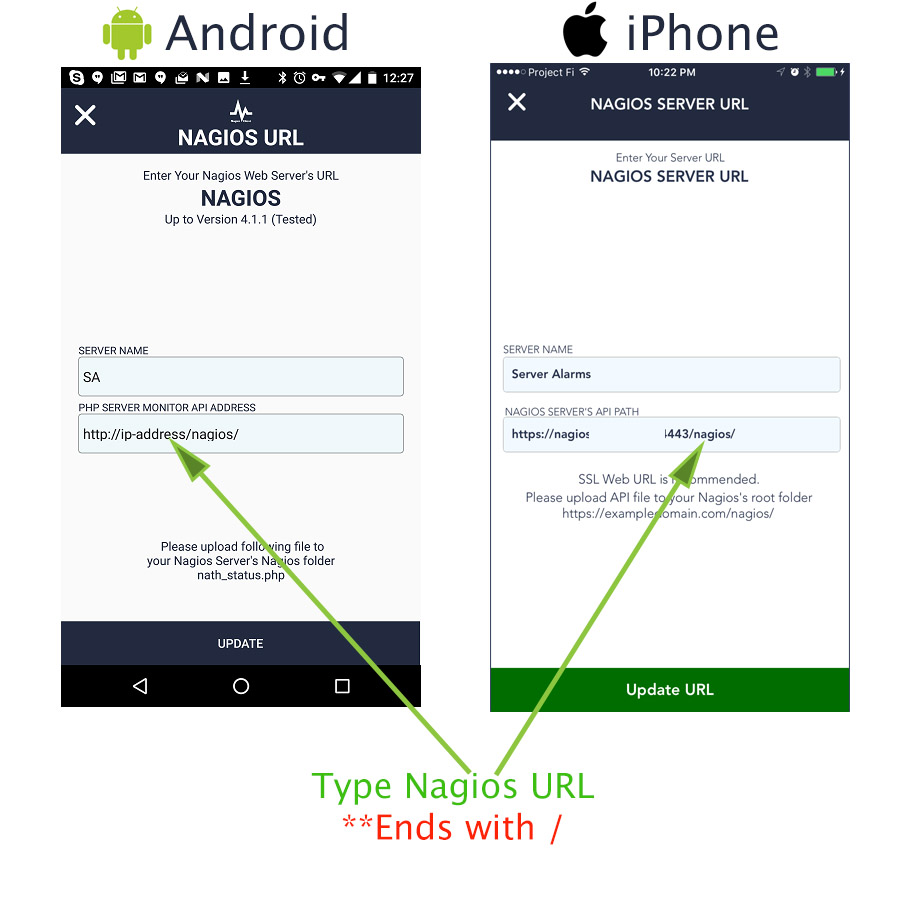This PHP API script reads Nagios status.dat file and return the JSON result. This API is desinged for Nagios Client unofficial Nagios status monitoring app.
Step 1
Upload nath_status.php to your Nagios web root folder.
###Nagios Core’s 3.5.1 default Web Root folder Web Root Folder – Centos /usr/share/nagios/html/
###Nagios Core’s default Web Root folder Web Root Folder – Centos & Ubuntu /usr/local/nagios/share/
###NagiosXI’s default Web Root folder Web Root Folder – Centos & Ubuntu /usr/local/nagiosxi/html/
Step 2
Edit nath_status.php. You can use your favourite text editor
vi /usr/local/nagios/share/nath_status.php
Change status.dat file’s path according to your Nagios Server configuration.
$statusFile = ‘/usr/local/nagios/var/status.dat’;
###Nagios Core’s 3.5.1 status.dat file’s location: /var/log/nagios/status.dat
Use following command to find status.dat location.
find / -name status.dat
Step 3
Download and Configure iPhone or Android Server Alarms Nagios Client
Go to settings

Step 4
Update URL ###Nagios Core (http or https)://nagiosserver_address/nagios/
###NagiosXI (http or https)://nagiosserver_address/nagiosxi/

###Add IOS Push Notification and Android FCM Notification
- 1 Download Script from following PHP Script File
- 2 Upload File to Nagios’s Plugin Folder**
/usr/local/nagios/libexec/
- 3 Make ServerAlarmNotify.php file executable using following command.
chmod +x ServerAlarmNotify.php
- 4 Edit commands.cfg and add following two commands. You will find your under settings. Menu -> Setting.

# 'sm-host-push-notify' command definition
define command{
command_name sm-host-push-notify
command_line /usr/local/nagios/libexec/ServerAlarmNotify.php $HOSTNAME$ YOURGROUPKEY HOST $HOSTSTATE$
}
# 'sm-service-push-notify' command definition
define command{
command_name sm-service-push-notify
command_line /usr/local/nagios/libexec/ServerAlarmNotify.php $HOSTNAME$ YOURGROUPKEY SERVICE $SERVICESTATE$
}
Step 5
Edit templates.cfg file. Modify Contact Templates and add sm-service-push-notify as service notification command and sm-host-push-notify as host notification command.
define contact{
name generic-contact
service_notification_period 24x7
host_notification_period 24x7
service_notification_options c,r
host_notification_options d,r
service_notification_commands notify-service-by-email,sm-service-push-notify
host_notification_commands notify-host-by-email,sm-host-push-notify
register 0
}
Step 6
Nagios Client Generates GROUP API KEY using Nagios URL
-
-
- All devices using same URL will get Notification simultaneously.
- Every Android/IOS user has option to Turn off Notification for his device only.
Step 7If your GROUP API KEY is not showing
-
- Update URL
- Turn OFF and ON Notification.
-
![]()
